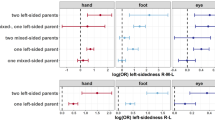Abstract
The data and analyses presented by Collins in his recent paper, “The Sound of One Paw Clapping”, are shown to provide no information regarding the relative roles of genes and environment in determining human hand preference. Arguments are given which establish that Collins misinterprets the sibling-sibling correlation and fails to test its significance. The genetic component of laterality is demonstrated to be very much underestimated by an analysis based on twin data. It is proved that a single environmental factor which produces parentoffspring resemblance necessarily yields a positive correlation between siblings and that Collins' “nongenetic model for the inheritance of handedness” is a tautology.
Similar content being viewed by others
References
Allen, G. (1955). Cases of cerebral palsy in a series of mentally defective twins.Am. J. Ment. Defic. 59: 629–639.
Allen, G., and Kallman, F. J. (1955). Frequency and types of mental retardation in twins.Am. J. Hum. Genet. 7: 15–20.
Bernstein, F. (1925).Sb. Preuss. Akad. Wiss. (Cited by Rife, 1933).
Bolin, B. J. (1953). Left-handedness and stuttering as signs diagnostic of epileptics.J. Ment. Sci. 99: 483–488.
Bulmer, M. G. (1970).The Biology of Twinning in Man, Clarendon Press, Oxford.
Collins, R. L. (1968). On the inheritance of handedness: I. Laterality in inbred mice.J. Hered. 59: 9–12.
Collins, R. L. (1969). On the inheritance of handedness: II. Selection for sinistrality in mice.J. Hered. 60: 117–119.
Collins, R. L. (1970). The sound of one paw clapping: an inquiry into the origin of left-handedness. In Lindzey, G., and Thiessen, D. D. (eds.),Contributions to Behavior-Genetic Anclysis: The Mouse as Prototype, Appleton-Century-Crofts, New York, pp. 115–136.
Dahlberg, G. (1926).Twin Births and Twins from a Hereditary Point of View, Tidens, Stockholm.
Downie, N. M., and Heath, R. W. (1959).Basic Statistical Methods, Harper, New York, p. 175.
Gordon, H. (1920). Lefthandedness and mirror writing especially among defective children.Brain 43: 313–368.
Guttmacher, A. F. (1937). An analysis of 521 cases of twin pregnancy: I. Differences in single and double ovum twinning.Am. J. Obstet. Gynecol. 34: 76–84.
Hirsch, N. D. M. (1930).Twins, Heredity, and Environment, Harvard University Press, Cambridge, Mass.
Hogben, L. (1933). The limits of applicability of correlation technique in human genetics.J. Genet. 27: 379–406.
Howard, R. G., and Brown, A. M. (1970). Twinning: A marker for biological insults.Child Develop.,41: 519–530.
Lauterbach, C. E. (1925). Studies in twin resemblance.Genetics 10: 525–568.
Levy, J. and Nagylaki, T. (1972). A model for the genetics of handedness.Genetics 72: 117–128.
Li, C. C. (1955).Population Genetics, University of Chicago Press, Chicago, p. 33.
McNemar, Q. (1955).Psychological Statistics, Wiley, New York, p. 203.
Mintz, A. (1947). Lateral preferences of a group of mentally subnormal boys.J. Genet. Psychol. 71: 75–84.
Newman, H. H. (1917).The Biology of Twins, University of Chicago Press, Chicago.
Newman, H. (1928). Asymmetry reversal or mirror imaging in identical twins.Biol. Bull. 55: 298–315.
Newman, H. (1940).Multiple Human Births, Doubleday, Doran, and Co., New York.
Newman, H., Freeman, F. N., and Holzinger, K. J. (1937).Twins: A Study of Heredity and Environment, University of Chicago Press, Chicago.
Pyle, W. H., and Drouin, A. (1932). Left-handedness: Experimental and statistical study.School and Society 36: 253.
Rife, D. C. (1933). Genetic studies of monozygotic twins.I, II, III,J. Hered. 24: 339–345, 407–414, 443–446.
Rife, D. C. (1940). Handedness, with special reference to twins.Genetics 25: 178–186.
Rife, D. C. (1950). An application of gene frequency analysis to the interpretation of data from twins.Hum. Biol. 22: 136–145.
Rosanoff, A. J., Handy, L. M., and Plesset, I. R. (1937). The etiology of mental deficiency with special reference to its occurrence in twins: A chapter in the genetic history of human intelligence.Psychol. Monogr. 48: Whole No. 216.
Siemens, H. W. (1924). Die Bedeutung der Zwillingspathologie für die aetiologische Forschung erläutert an Beispeil der Linkshändigkeit.Ges. Morphol. Physiol. (Cited by Newman, 1928).
Stocks, P. (1933). A biometric investigation of twins and their brothers and sisters.Ann. Eugen. 5: 1–55.
von Verschuer, O. (1927). Der vererbungsbiologische Zwillingsforschung.Ergeb. Innern. Med. Kinderheit 31, (Cited by Newman, 1928).
Weiner, G., Rider, R. V., Oppel, W. C., Fisher, L. K., and Harper, P. A. (1965). Correlates of low birth weight: Psychological status at six to seven years of age.Pediatrics 35: 434–444.
Weitz, W. (1924). Studien an eineiigen Zwillingen.Klin. Med. 101. (Cited by Newman, 1928).
Wilson, M. O., and Dolan, L. B. (1931). Handedness and ability.Am. J. Psychol. 43: 261–268.
Wilson, P. T., and Jones, H. E. (1932). Left-handedness in twins.Genetics 17: 560–571.
Author information
Authors and Affiliations
Additional information
A reply by Dr. Collins entitled “Human Handedness and the Call to Arms: Heritable? Yes; Genetic? No” will appear in a forthcoming issue.
Rights and permissions
About this article
Cite this article
Nagylaki, T., Levy, J. “The Sound of One Paw Clapping” isn't sound. Behav Genet 3, 279–292 (1973). https://doi.org/10.1007/BF01067605
Received:
Accepted:
Issue Date:
DOI: https://doi.org/10.1007/BF01067605




